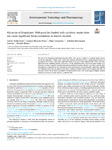Filtration of Biopolymer PHB Particles Loaded With Synthetic Musks Does Not Cause Significant Bioaccumulation in Marine Mussels

Use este enlace para citar
http://hdl.handle.net/2183/33252
A non ser que se indique outra cousa, a licenza do ítem descríbese como Atribución-NoComercial-SinDerivadas 4.0 Internacional
Coleccións
- Investigación (FCIE) [1150]
Metadatos
Mostrar o rexistro completo do ítemTítulo
Filtration of Biopolymer PHB Particles Loaded With Synthetic Musks Does Not Cause Significant Bioaccumulation in Marine MusselsAutor(es)
Data
2023-03-03Cita bibliográfica
Leticia Vidal-Liñán, Carmen Moscoso-Pérez, Filipe Laranjeiro, Soledad Muniategui-Lorenzo, Ricardo Beiras, Filtration of biopolymer PHB particles loaded with synthetic musks does not cause significant bioaccumulation in marine mussels, Environmental Toxicology and Pharmacology, Volume 99, 2023, 104092, ISSN 1382-6689, https://doi.org/10.1016/j.etap.2023.104092. (https://www.sciencedirect.com/science/article/pii/S1382668923000340)
Resumo
[Abstract] The role of the biopolymer polyhydroxybutyrate (PHB, <250 µm) as a vehicle of a synthetic musks mixture (celestolide, galaxolide, tonalide, musk xylene, musk moskene and musk ketone) to Mytilus galloprovincialis was investigated. For 30 days, virgin PHB, virgin PHB+musks (6.82 µg g-1) and weathered PHB+musks, were daily spiked into tanks containing mussels, followed by a 10-day depuration period. Water and tissues samples were collected to measure exposure concentrations and accumulation in tissues. Mussels were able to actively filter microplastics in suspension but the concentration of the musks found in tissues (celestolide, galaxolide, tonalide) were markedly lower than the spiked concentration. Estimated Trophic Transfer Factors suggest that PHB will only play a minor role on musks accumulation in marine mussels, even if our results suggest a slightly extended persistence in tissues of musks loaded to weathered PHB.
Palabras chave
Bivalve
Filtering rate
Hydrophobic organic compounds
TTF
Desorption
Plastic
Cosmetic
Fragrance
Filtering rate
Hydrophobic organic compounds
TTF
Desorption
Plastic
Cosmetic
Fragrance
Versión do editor
Dereitos
Atribución-NoComercial-SinDerivadas 4.0 Internacional
ISSN
1382-6689






